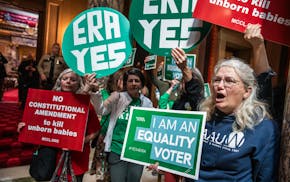This week, Virginia's legislature approved, and its governor is expected to sign, a resolution to ratify the Equal Rights Amendment, which proposes that "equality of rights under the law shall not be denied or abridged by the United States or by any state on account of sex." That would make the commonwealth the 38th state to assent, meeting the three-quarters threshold for an amendment to become part of the U.S. Constitution.
In this case, however, it's not that simple. When Congress sent the ERA to the states in 1972, it included a seven-year deadline, subsequently modified to 10 years. The amendment was ratified by 35 states (including Minnesota) during that time, falling short. Whether Congress can modify the deadline again retroactively, or rescind it, or whether the limit was legitimate in the first place given its placement in the introduction of the amendment instead of the text, are questions amendment supporters intend to press. The issue is further complicated by five states' ostensibly having rescinded their ratifications.
So, Americans can celebrate a milestone in gender equality while lamenting the legal morass that will follow.
The Constitution does not require a time limit on proposed amendments, nor does it prohibit one. Eight other ratified amendments have included one (four in the text, four in the intro). On the other hand, what is now the 27th Amendment, declaring that no change in pay for senators and representatives can take effect until after an election, was conceived in 1779 as part of the Bill of Rights but not ratified until 1992, nearly 203 years later. The Supreme Court, faced with a dispute over ratification procedures in 1939, deferred to Congress.
Typically, when an amendment reaches the threshold, the following process occurs:
• The Office of the Federal Register verifies that it has received the required number of authenticated ratification documents.
• The Archivist of the United States certifies that the text has become part of the Constitution.
This month, the Justice Department's Office of Legal Counsel — acting on the request of the National Archives and Records Administration, which is led by the archivist, who had been sued by three states seeking to halt the ERA process — concluded that since the 1982 deadline has passed, the amendment is, well, dead.
Arguments for and against the ERA are much the same as they always have been, though times have evolved. Supporters acknowledge progress in gender equality — in large measure due to legislation and to rulings under the Equal Protection Clause of the 14th Amendment on civil rights — but believe the amendment can bring clarity on lingering disparities while resolving a fundamental omission in the Constitution. Opponents fear that the generality of the text will allow undesirable applications. Still others support the goals but believe the process must begin anew.
Twenty-five states have adopted language like that of the ERA. In Minnesota, a move to put such a question on the 2020 ballot was approved in the House in 2019 but has yet to advance in the Senate.
Such action would help, but when rights that ought not vary from state to state are in question, federal solutions are best. Given the current climate in Washington, however, a new amendment is unlikely in the foreseeable future. Taking the status of ratification to the courts, murky as it is, may be the clearest path to further progress.
Pass guardrails for HCMC governance changes

Minnesota needs an ERA that includes gender and reproductive freedom

Legislature must clarify sex, gender before putting an ERA before Minnesota voters

Legislature must act — properly — on Uber and Lyft before adjourning

